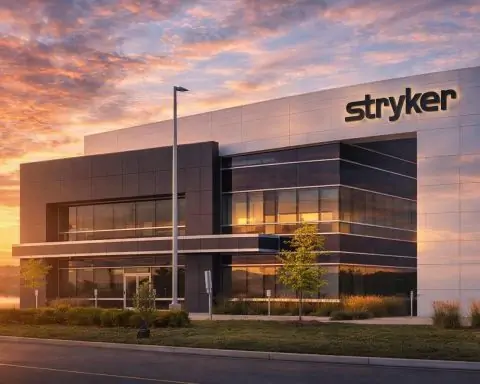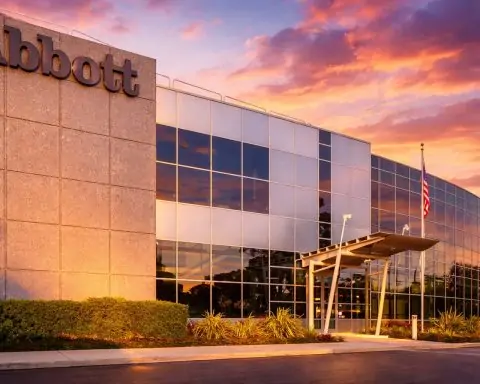Key facts (Sept. 25–26, 2025)
- Catalyst: On Sept. 25, SciSparc (NASDAQ: SPRC) said its board resolved to launch a quantum‑computing–enabled 3D protein‑modeling initiative to accelerate AI drug discovery, with plans to form a dedicated Israeli subsidiary and collaborate with quantum and structural‑biology experts. [1]
- Stock reaction (Sept. 25): Shares closed +59.0% at $6.09, after trading between $5.25–$8.90; volume jumped to ~89.38 M vs ~161k the prior day (a ~555× spike). [2]
- Early Sept. 26 tape: By 05:46 a.m. ET, extended hours showed SPRC at $5.38 (‑11.66%) from the prior close. [3]
- Official filing: A Form 6‑K furnished Sept. 25 attached the press release and also disclosed management changes resolved Sept. 21—Amitay Weiss became President and Itschak Shrem Chairman. [4]
- Merger overhang: Earlier (Sept. 16), the Jerusalem District Court granted AutoMax’s motion to stay proceedings on the SciSparc–AutoMax merger until Sept. 30, citing uncertainty around meeting closing conditions. (Shareholders on both sides approved the deal Aug. 28.) [5]
- Share‑structure context: SciSparc executed a 1‑for‑21 reverse split effective July 3 and regained Nasdaq bid‑price compliance July 22—factors that can amplify volatility when headline catalysts hit. [6]
What happened — and why it matters
SciSparc’s new program aims to apply quantum algorithms to hard problems in protein folding and protein–ligand interactions, with the goal of more precise simulations that speed discovery in neurological and rare diseases. The board authorized creating a wholly‑owned Israeli subsidiary to run the effort and to pursue IP around the methods. [7]
The announcement comes alongside leadership changes disclosed in the same 6‑K: Amitay Weiss (formerly chair) moves into the President role, while Itschak Shrem becomes Chairman. Those shifts predate the quantum news (Sept. 21 resolution) but land in the same reporting window, adding to the “reset” narrative. [8]
Market reaction: The stock’s +59% surge on Sept. 25 coincided with exceptionally high liquidity (≈89.38 M shares vs ≈161k on Sept. 24). Trading subsequently cooled in early Sept. 26 extended hours ($5.38, ‑11.7% vs prior close), a pattern typical after parabolic moves. [9]
The unresolved M&A backdrop
While SciSparc shareholders approved the planned merger with AutoMax Motors on Aug. 28, a Sept. 16 court order stayed proceedings to Sept. 30 amid uncertainty AutoMax could satisfy closing conditions. That legal overhang remains a near‑term binary for the equity, independent of the quantum initiative. [10]
Where SciSparc’s pivot sits in the wider science & tech trend
Quantum for life sciences is advancing—carefully. A Nature Catalysis perspective published Sept. 24 captures both promise and reality: “current quantum hardware is constrained by noise, limited qubit coherence and high error rates.” That constraint is central to timelines for real‑world drug‑discovery impact. [11]
At the same time, milestones are stacking up. IonQ and Kipu Quantum reported in June the largest protein‑folding problem run on quantum hardware (3D case up to 12 amino acids). IonQ’s SVP Ariel Braunstein said the collaboration “sets a new standard for what’s possible in quantum computing today” (press release). [12]
And outside biopharma, quantum is moving toward usable platforms. On Sept. 25, Cisco unveiled software to stitch together quantum machines from different vendors; as Cisco’s Vijoy Pandey put it, “We will handle that complexity” for developers—underscoring the ecosystem’s shift toward practical tooling. [13]
Takeaway: SciSparc’s initiative is aligned with a rising industry wave, but translation to pipeline value depends on partnerships, hardware access, algorithms, data—and time.
How SPRC compares with “similar topics” (peers and approaches)
1) Classical AI / physics‑based discovery (established revenue models)
- Schrödinger (NASDAQ: SDGR) sells mature computational‑chemistry software and runs a discovery pipeline. In Q2 2025, it reported $54.8 M total revenue ($40.5 M software). CEO Ramy Farid cited demand for “proven computational technologies to accelerate molecular discovery.” SciSparc, by contrast, is pre‑revenue in software and is proposing a new quantum line of effort. [14]
- Recursion (NASDAQ: RXRX) exemplifies AI‑at‑scale. NVIDIA’s $50 M strategic investment and collaboration (2023) supports foundation models for biology/chemistry—highlighting how large compute plus proprietary data can attract deep‑tech partners. SciSparc’s plan is earlier‑stage and would rely on external quantum stacks rather than hyperscale GPU clouds. [15]
2) Quantum‑first enablers (hardware/platforms)
- IonQ (NYSE: IONQ) and partners (e.g., Kipu Quantum) are demonstrating record protein‑folding runs on quantum hardware—still small biological systems, but concrete progress that companies like SciSparc could consume as customers. [16]
- Ecosystem tooling (e.g., Cisco’s multi‑vendor orchestration) suggests vendor‑agnostic pathways for end users like SciSparc to test algorithms across platforms—critical given rapid hardware churn. [17]
Bottom line on comparisons:
- Scale & revenue: Established computational players (SDGR, RXRX) show recurring revenue or deep funding; SciSparc is microcap, with high volatility and no disclosed software revenue today. [18]
- Technology maturity: Quantum‑assisted discovery is exciting but early, with hardware limits acknowledged in the literature; real therapeutic impact typically lags years behind tooling breakthroughs. [19]
Company context investors are weighing
- Programs & focus: SciSparc remains a specialty clinical‑stage pharma with cannabinoid‑based programs (SCI‑110 for Tourette’s and Alzheimer’s/agitation; SCI‑210 for ASD/status epilepticus) and a consumer subsidiary. The quantum effort is an adjacent R&D platform, not a replacement for its CNS pipeline. [20]
- Share structure & listing: The July 1‑for‑21 reverse split and July bid‑price compliance restoration mean fewer shares and a higher nominal price—conditions that can magnify intraday moves on news. [21]
- Capital access: The company’s IR page shows recent F‑3/A activity (July 22) and a notice of effectiveness (July 30), implying a ready financing shelf—a consideration whenever microcaps rally sharply. [22]
What to watch next (near‑term)
- Court milestone: Any update around the Sept. 30 AutoMax stay and whether conditions for closing are met (or not). [23]
- Quantum program specifics:Hardware partners, academic collaborators, and proof‑of‑concepts for folding or docking at scales relevant to CNS targets. [24]
- Financing signals: New capital‑raise filings or ATM activity given the post‑headline surge and existing shelf. [25]
- Pipeline news: Clinical readouts or regulatory interactions on SCI‑110/SCI‑210, which ultimately anchor valuation more than platform announcements. [26]
Expert voices (in brief)
- Nature Catalysis (Sept. 24): “current quantum hardware is constrained by noise, limited qubit coherence and high error rates.” (Perspective on quantum for enzyme discovery.) [27]
- IonQ (June): Quantum collaboration “sets a new standard for what’s possible in quantum computing today.” (Ariel Braunstein, SVP Product). [28]
- Schrödinger (Aug. 6): Demand for “proven computational technologies to accelerate molecular discovery.” (CEO Ramy Farid, PhD). [29]
- Cisco/Reuters (Sept. 25): “We will handle that complexity” for developers using multi‑vendor quantum clouds. (Vijoy Pandey, SVP Outshift). [30]
All news we found dated Sept. 25–26, 2025 (primary & corroborating items)
- Sept. 25 (07:05 ET) — SciSparc press release: launch of quantum‑enabled 3D protein modeling initiative (core details, subsidiary plan, targets). [31]
- Sept. 25 (furnished same day) — Form 6‑K: attaches press release; also notes management changes (Weiss/Shrem) resolved Sept. 21. [32]
- Sept. 25 — Coverage of the initiative and price move across outlets (Investing.com, RTTNews/others) documenting the surge and unusual volume. [33]
- Sept. 25 (end‑of‑day data) — Yahoo Finance historicals: close $6.09, high $8.90, volume 89.38 M. [34]
- Sept. 26 (05:46 a.m. ET) — MarketBeat extended‑hours snapshot: $5.38 (‑11.66%). [35]
(No additional company press release was posted on Sept. 26 as of publication time; the tape reflected digestion of the prior day’s headline.) [36]
Editorial view for a public audience
SciSparc’s two‑day news cycle blended science signaling (a quantum‑assisted modeling program that matches where the field is heading) with microcap mechanics (tight share count after a reverse split, prior listing pressures, and an M&A stay hanging over the story). The initiative itself is directionally credible given recent quantum progress and mainstream coverage of enabling stacks—but as the Nature perspective reminds us, hardware limitations still cap what can be done on real biomolecules today. Expect investors to demand concrete collaborations, benchmarks, and reproducible results before assigning durable value to this pivot. [37]
Sources & further reading
- SciSparc press release (Sept. 25) and Form 6‑K (same day) with leadership changes. [38]
- Yahoo Finance historical price/volume for Sept. 25 and prior day. [39]
- MarketBeat extended‑hours snapshot (Sept. 26). [40]
- AutoMax merger: shareholder votes (Aug. 28) and court stay to Sept. 30 (Sept. 16 6‑K). [41]
- Reverse split (July 3) and Nasdaq compliance (July 22). [42]
- Quantum context: Nature Catalysis (Sept. 24), IonQ–Kipu (June 19), Cisco/Reuters (Sept. 25). [43]
Disclosure: This article is for information purposes only and is not investment advice. Micro‑cap biotech and quantum‑technology equities are highly volatile and speculative.
References
1. www.globenewswire.com, 2. finance.yahoo.com, 3. www.marketbeat.com, 4. www.sec.gov, 5. www.sec.gov, 6. www.sec.gov, 7. www.globenewswire.com, 8. www.sec.gov, 9. finance.yahoo.com, 10. www.globenewswire.com, 11. www.nature.com, 12. investors.ionq.com, 13. www.reuters.com, 14. ir.schrodinger.com, 15. ir.recursion.com, 16. investors.ionq.com, 17. www.reuters.com, 18. ir.schrodinger.com, 19. www.nature.com, 20. www.globenewswire.com, 21. www.sec.gov, 22. investor.scisparc.com, 23. www.sec.gov, 24. www.globenewswire.com, 25. investor.scisparc.com, 26. www.globenewswire.com, 27. www.nature.com, 28. investors.ionq.com, 29. ir.schrodinger.com, 30. www.reuters.com, 31. www.globenewswire.com, 32. www.sec.gov, 33. www.investing.com, 34. finance.yahoo.com, 35. www.marketbeat.com, 36. www.globenewswire.com, 37. www.nature.com, 38. www.globenewswire.com, 39. finance.yahoo.com, 40. www.marketbeat.com, 41. www.globenewswire.com, 42. www.sec.gov, 43. www.nature.com







